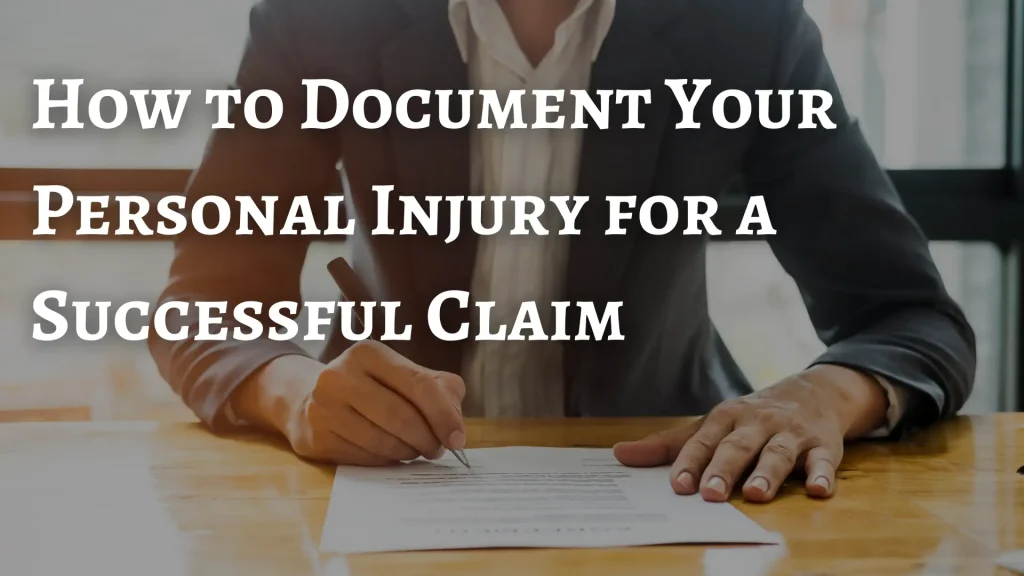
Strong evidence turns a claim into a case. Insurance companies won’t just take your word for it when injuries disrupt your life; they want proof. That proof starts with what you document in the hours, days, and weeks after the accident. Documenting your file on a personal injury claim thoroughly—from medical records to photos and witness statements—can make a big difference in the strength and success of your case.
The importance of documenting your injuries can’t be overstated. Clear records—like medical reports, photos, and personal notes—help prove the severity of your condition.
A skilled Fort Walton Beach personal injury lawyer looks beyond the medical records. They will examine every photo, receipt, and written note to help show the full impact of what happened. With the right documentation, your case carries more weight, and your chance at fair compensation grows stronger.
Why Documentation Matters in Personal Injury Claims?
Every personal injury claim must prove three things: someone caused your injury, you suffered real harm, and there’s a clear link between the two. Without records, the defense can question every part of your story. Even simple cases lose traction when the injured person shows up without paperwork or consistent details.
Documenting a personal injury claim helps you:
- Build legal proof of accident injury
- Show the timeline of your treatment and recovery
- Support pain and suffering damages
- Respond to challenges from the defense or insurer
Courts and insurance adjusters rely on records, not assumptions. Thorough documentation helps confirm the severity of your injuries, how long you needed treatment, and how the injury affected your daily life.
Key Items to Document After an Injury
The more details you capture, the stronger your case becomes. These key categories offer the clearest snapshot of what you went through:
- Post-accident photo evidence: Take clear pictures of the scene, property damage, visible injuries, and anything that may have caused the accident. If possible, capture different angles and lighting.
- Accident report evidence: File a police report, incident report, or workplace accident report. These documents help establish that the event occurred and who was involved.
- Medical records: Request all records from hospitals, doctors, and physical therapists. In a legal case, include discharge summaries, X-rays, and doctor notes.
- Pain and suffering journal: Write daily notes about your symptoms, medications, emotional state, and how your injury affects work or family life.
- Witness statements for an accident claim: Collect names and contact information for anyone who saw the incident. If possible, ask them to describe what they saw in writing.
- Receipts for injury expenses: Keep receipts for prescriptions, medical equipment, travel to appointments, and anything else tied to your injury.
Each document supports your legal position and shows that you took the injury and recovery seriously.
Tips for Organizing Your Injury Documentation
You gather the facts, but that’s not enough. You must sort and label them clearly so your attorney can quickly find what matters. A stack of unmarked papers or an unorganized email inbox slows your case, wastes time, and risks missing key details that could change the outcome.
Use these injury documentation tips to stay on top of the process:
- Create folders or digital files for each type of document: medical records, receipts, photos, journals, and reports.
- Label everything with dates, names, and a short description.
- Keep a running treatment timeline for personal injury: note every appointment, diagnosis, procedure, and medication.
- Back up digital files to the cloud or an external drive.
- Bring a copy of your documents to every legal meeting.
Clear, consistent organization shows that you initially took supporting your claim seriously. It also helps avoid gaps that insurers might use against you.
Documenting a personal injury claim over time
Some injuries don’t heal quickly—or at all. Recovery often happens in phases, and pain may come and go. Tracking your symptoms over time shows you the full scope of what you’ve endured.
Use a journal for personal injury recovery to note:
- Days when pain keeps you from working or leaving the house
- Missed events or disrupted routines
- New symptoms or reactions to treatment
- Emotional struggles like anxiety or depression
Photos help, too. Take regular pictures of visible injuries or mobility aids to track progress or setbacks. These visual records support your narrative and help show how your condition changed from week to week.
Please read more about insurance claim denial here: Can Insurance Companies Deny Claims for Pre-Existing Conditions?
How Good Records Strengthen Your Legal Case
Detailed records help your legal team push back against weak defenses and stand firm in negotiations. The defense has less room to twist the facts when your claim includes consistent, dated, and thorough documentation.
- Respond to pre-existing condition defenses with solid medical histories
- Counterclaims of exaggeration with consistent, dated records
- Show that your injuries didn’t exist before the accident
- Prove that you followed medical advice and took recovery seriously
Well-kept records help your personal injury attorney calculate fair damages for medical care, pain, lost income, and future treatment. Insurers pay closer attention when they see hard visual evidence instead of vague claims.
Defense lawyers look for gaps, contradictions, or signs that a client didn’t treat their recovery like a priority. Strong documentation removes those doubts.
Don’t Forget the Emotional and Financial Impact
 Injuries cause more than physical pain. They take away your routine, strain your relationships, and force you to make hard choices about work, family, and your future. That impact deserves attention.
Injuries cause more than physical pain. They take away your routine, strain your relationships, and force you to make hard choices about work, family, and your future. That impact deserves attention.
Include these types of injury claim paperwork when possible:
- Letters from employers showing missed work
- Notes from counselors or therapists
- Childcare costs or home help tied to your injury
- Statements from family or friends about how your behavior or ability changed
These details focus on the human cost of your injury. They also support non-economic damages like emotional distress and loss of enjoyment of life.
Talk to a Fort Walton Beach Personal Injury Lawyer
At The Bruner Law Firm, we treat injury documentation like the foundation of every case we build. We don’t rely on assumptions—we rely on proof backed by solid records, consistent timelines, and detailed reporting from day one.
If you’ve been hurt and want to protect your right to compensation, build your case piece by piece. Our Fort Walton Beach personal injury lawyer team knows what insurance companies try to challenge and how to present your evidence clearly and effectively. Our team is here to help you understand your rights and take the first step toward securing the necessary benefits. Reach out today, and let us show you how strong documentation can make a meaningful difference in your case. Give us a call at (850) 243-2222.







